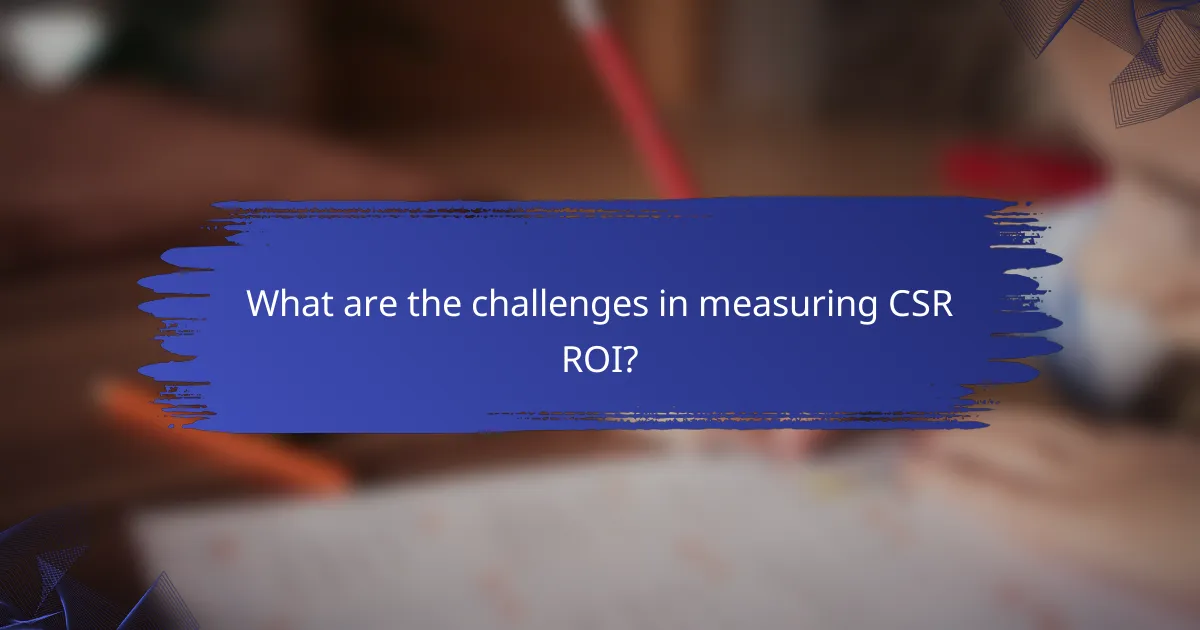Measuring the return on investment (ROI) of corporate social responsibility (CSR) is crucial for organizations seeking to understand the full impact of their initiatives. By evaluating both quantitative and qualitative outcomes, companies can assess financial benefits, social contributions, and stakeholder perceptions, ultimately enhancing their business performance and community welfare.

How to measure CSR ROI effectively?
Measuring CSR ROI effectively involves evaluating both quantitative and qualitative outcomes of corporate social responsibility initiatives. This assessment helps organizations understand the financial benefits, social contributions, and overall impact of their CSR efforts.
Financial metrics
Financial metrics assess the direct economic benefits of CSR activities, such as increased sales, cost savings, and improved profitability. Common indicators include return on investment (ROI), cost-benefit analysis, and revenue growth attributed to CSR initiatives.
To calculate ROI, consider both the costs associated with CSR programs and the financial gains realized over time. For example, a company might invest thousands in a community project but see a boost in customer loyalty that translates to millions in revenue.
Social impact metrics
Social impact metrics evaluate the effects of CSR initiatives on communities and stakeholders. These can include measures of community well-being, employee satisfaction, and social equity improvements.
Tools like surveys and social return on investment (SROI) calculations can help quantify these impacts. For instance, a company might track changes in local employment rates or educational outcomes resulting from its community engagement efforts.
Environmental impact metrics
Environmental impact metrics focus on the ecological benefits of CSR initiatives, such as reductions in carbon emissions, waste management improvements, and resource conservation. Companies often track metrics like energy usage, water consumption, and waste reduction percentages.
For example, a firm that implements a recycling program may measure the volume of materials diverted from landfills, translating these figures into environmental benefits and potential cost savings over time.
Stakeholder engagement metrics
Stakeholder engagement metrics assess the effectiveness of CSR communication and collaboration with various stakeholders, including employees, customers, and community members. Key indicators include stakeholder feedback, participation rates in CSR programs, and partnership effectiveness.
Surveys and engagement scores can provide insights into how well stakeholders perceive and participate in CSR initiatives. High engagement levels often correlate with stronger brand loyalty and community support.
Brand reputation metrics
Brand reputation metrics evaluate how CSR efforts influence public perception and brand equity. These can include brand awareness, customer loyalty, and overall reputation scores from third-party assessments.
Monitoring social media sentiment and conducting brand perception surveys can help companies gauge the impact of their CSR initiatives on reputation. Positive CSR activities often lead to enhanced brand image and customer trust, which can be quantified through increased sales or market share.

What are the key metrics for assessing CSR value?
Key metrics for assessing Corporate Social Responsibility (CSR) value include financial returns, social impact, and stakeholder perceptions. These metrics help organizations evaluate the effectiveness of their CSR initiatives and their overall contribution to business objectives and community welfare.
Return on investment (ROI)
Return on investment (ROI) measures the financial return generated from CSR activities relative to their costs. To calculate ROI, divide the net profit from CSR initiatives by the total investment in those initiatives, then multiply by 100 to get a percentage. A positive ROI indicates that the CSR efforts are financially beneficial.
For example, if a company invests $100,000 in a sustainability program and generates an additional $150,000 in revenue as a result, the ROI would be 50%. Organizations should consider both direct and indirect benefits when assessing ROI, as some impacts may not be immediately quantifiable.
Cost-benefit analysis
A cost-benefit analysis evaluates the total expected costs against the total expected benefits of CSR initiatives. This method helps organizations determine whether the benefits outweigh the costs and to what extent. It involves identifying all costs, including implementation and operational expenses, and quantifying benefits in financial terms.
For instance, if a company spends €200,000 on a community development project that leads to €300,000 in increased sales and improved brand loyalty, the cost-benefit ratio would be 1.5:1. This analysis is crucial for decision-making and prioritizing CSR projects that yield the highest value.
Social return on investment (SROI)
Social return on investment (SROI) measures the social, environmental, and economic value created by CSR initiatives relative to the investment made. SROI quantifies social impact in monetary terms, allowing organizations to understand the broader effects of their CSR efforts. It is calculated by comparing the value of social outcomes to the investment costs.
For example, if a company invests $50,000 in an educational program that generates $200,000 in social value, the SROI would be 4:1. This metric helps organizations communicate the value of their CSR activities to stakeholders and justify investments in social initiatives.
Net promoter score (NPS)
Net promoter score (NPS) gauges customer loyalty and satisfaction based on their likelihood to recommend a company to others. This metric can be influenced by CSR initiatives, as customers often prefer brands that demonstrate social responsibility. NPS is calculated by subtracting the percentage of detractors from the percentage of promoters.
For instance, if 70% of customers are promoters and 10% are detractors, the NPS would be 60. A high NPS indicates strong customer loyalty, which can be a direct result of effective CSR strategies. Companies should regularly track NPS to assess the impact of their CSR efforts on customer perception and loyalty.

How does CSR impact business performance in the UK?
Corporate Social Responsibility (CSR) significantly influences business performance in the UK by enhancing customer loyalty, employee satisfaction, and brand image. Companies that effectively implement CSR initiatives often see improved financial outcomes and a stronger market position.
Increased customer loyalty
CSR initiatives can lead to increased customer loyalty as consumers are more likely to support brands that align with their values. In the UK, a growing number of customers prefer to purchase from companies that demonstrate social and environmental responsibility.
To foster loyalty, businesses should communicate their CSR efforts clearly and authentically. For instance, brands that engage in sustainable practices or support local communities often see higher repeat purchase rates, sometimes exceeding 60% among loyal customers.
Enhanced employee satisfaction
Implementing CSR strategies can enhance employee satisfaction by creating a positive workplace culture. Employees are generally more motivated and engaged when they feel their company contributes to societal well-being.
In the UK, organizations that prioritize CSR often report lower turnover rates and higher productivity. Companies can enhance satisfaction by involving employees in CSR activities, which fosters a sense of ownership and pride in their work.
Improved brand image
A strong CSR commitment can significantly improve a company’s brand image. In the competitive UK market, businesses that actively promote their social responsibility initiatives are often viewed more favorably by consumers and stakeholders.
To effectively enhance brand image, companies should focus on transparency and accountability in their CSR efforts. Regularly sharing progress and outcomes can build trust and strengthen relationships with customers, potentially leading to a 20-30% increase in positive brand perception.

What frameworks exist for CSR ROI evaluation?
Several frameworks are available for evaluating the return on investment (ROI) of corporate social responsibility (CSR) initiatives. These frameworks help organizations measure the impact of their CSR activities on both financial performance and social value creation.
Global Reporting Initiative (GRI)
The Global Reporting Initiative (GRI) provides a comprehensive framework for sustainability reporting, enabling organizations to disclose their economic, environmental, and social impacts. By following GRI standards, companies can assess their CSR performance and communicate their contributions to stakeholders effectively.
Organizations using GRI can benefit from a structured approach to reporting, which includes specific indicators and metrics. This allows for comparisons across industries and regions, enhancing transparency and accountability in CSR efforts.
ISO 26000 guidelines
ISO 26000 offers guidance on social responsibility, helping organizations integrate CSR into their operations. Unlike certification standards, ISO 26000 is a voluntary framework that emphasizes principles such as accountability, transparency, and ethical behavior.
Implementing ISO 26000 involves assessing existing practices against its core subjects, including organizational governance, human rights, labor practices, and community involvement. Companies can use this framework to identify areas for improvement and enhance their overall CSR strategy.

What are the challenges in measuring CSR ROI?
Measuring the return on investment (ROI) for corporate social responsibility (CSR) initiatives presents several challenges that can complicate evaluation. These challenges include difficulties in data collection, attribution issues regarding the impact of CSR activities, and the inherent subjectivity involved in assessing their effects.
Data collection difficulties
Collecting data for CSR ROI can be challenging due to the diverse nature of CSR activities and the lack of standardized metrics. Companies often struggle to gather consistent data across different departments or regions, leading to incomplete or unreliable information.
For example, a company may implement an environmental initiative that reduces waste, but quantifying the financial savings or environmental benefits can be complex. Establishing clear data collection processes and utilizing technology can help mitigate these issues.
Attribution issues
Attribution issues arise when trying to link specific CSR initiatives to measurable business outcomes. It can be difficult to determine whether improvements in brand reputation, customer loyalty, or employee satisfaction are directly due to CSR efforts or other factors.
To address this, businesses can employ methods such as control groups or longitudinal studies to better isolate the effects of their CSR activities. However, these methods can be resource-intensive and may not always yield clear results.
Subjectivity in impact assessment
The assessment of CSR impact often involves subjective judgments, making it hard to quantify benefits accurately. Different stakeholders may have varying opinions on what constitutes a successful CSR initiative, leading to inconsistent evaluations.
To reduce subjectivity, organizations can establish clear criteria for success and utilize third-party assessments or benchmarks. This approach can help create a more objective framework for evaluating CSR ROI, though it may still require careful interpretation of qualitative data.

What are the emerging trends in CSR ROI measurement?
Emerging trends in CSR ROI measurement focus on integrating sustainability metrics into financial performance assessments. Companies are increasingly adopting innovative frameworks and technologies to quantify the impact of their corporate social responsibility initiatives.
Integration of ESG Factors
Environmental, Social, and Governance (ESG) factors are becoming essential in CSR ROI measurement. Businesses are recognizing that strong ESG performance can enhance brand reputation and lead to better financial outcomes. For instance, companies with high ESG ratings often experience lower capital costs and improved investor interest.
Use of Technology and Data Analytics
Advancements in technology and data analytics are transforming how organizations measure CSR ROI. Companies are leveraging big data and AI to analyze the effectiveness of their CSR initiatives in real-time. This allows for more accurate assessments and adjustments to strategies, ensuring better alignment with stakeholder expectations.
Stakeholder Engagement and Reporting
Engaging stakeholders in the CSR ROI measurement process is increasingly important. Companies are now prioritizing transparent reporting that reflects stakeholder concerns and expectations. Regular communication through sustainability reports and updates can enhance trust and demonstrate accountability.
Focus on Long-Term Value Creation
There is a growing emphasis on long-term value creation rather than short-term gains in CSR ROI measurement. Organizations are shifting their focus to sustainable practices that yield benefits over time, such as improved employee satisfaction and customer loyalty. This approach often leads to a more resilient business model.










